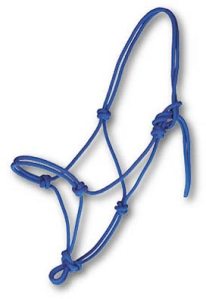My friend Eileen, who owns James and Madison, né Windsong’s Justa Handful and Justa Royal Sojourner (respectively) by my stallion Windsong’s Justa Firestorm, sent me an article that speaks volumes to the growing trend of close examination of the natural horsemanship trend. Every trend, even those so ingrained that certain features become permanent features of their general landscape, has its heyday and passes over eventually. I have been a rather careful critic of much of natural horsemanship as it is practiced by the average horse person, and I have to confess to being thrilled that Eleanor Van Natta, author of the blog, Sage by Nature, wrote a Nov. 25 article in horsecity.com entitled, A Face-Off With Rope Halters: They’re Knot So Natural After All . The cute title gives an indication of one of her objections to the ubiquitous natural horsemanship-type rope halter.

typical rope halter
Rope halters are very lightweight, which is nice, but the knots that are positioned in various places and number are very harsh and severe on the sensitive face of the horse. Rope halters can certainly demand a horse’s immediate attention, but is communication through pain really what we are after? When was screaming more effective than whispering?
She goes on to wonder how many amateur horse owners and trainers who enjoy the rapid results they get with the rope halter can get the same results without it. She also wonders whether they are aware of the potential fact that the “release” or reaction of the horse is due to pain or anticipation of pain rather than obedience and responsiveness.
Just about every user of the rope halter is a victim of flashy marketing or the persuasion of someone who should know better. I know I was. Virtually every trainer and riding teacher I ever had used them–except Wizard Liz, who, in her typical Yankee fashion, “could see no real use for those silly things.” Unless used by exceedingly capable hands (think John Lyons), the potential for causing harm and teaching our horses that the halter is a control device rather than a communication device is too great.
She says,
I kept finding as I scanned and Googled the internet … that the rope halter was an effective means of communication (except for a few horror stories in forums of horses tied up in rope halters or the halters left on them for extended periods of time). But are you simply communicating that you can inflict pain and discomfort on this animal with minimal effort? I had been convinced by natural horsemanship books and videos before buying my halter that the horse is teaching himself with these halters because of the release from pressure. The word pain was never actually used the words used were “discomfort” and “pressure”. A horse is so sensitive as to be able to feel the landing of a fly that weighs less than the weight of a few average sized raindrops. I have made many mistakes with my horse over the years, but perhaps not respecting the lightness of a fly has been one of the biggest mistakes of all. I am a big believer now that there is something inherently wrong with putting something on that sensitive face that can inflict pain for the sake of control and all the while calling it “natural”.
In addition to the dangers caused by ineffective use of the halter in training and the design of the halter itself, there is the plethora of inexpensive knockoff rope halters with poor workmanship and incorrect proportions. Together with inexpert handling, a cheap halter from the local tractor shop might as well be an instrument of torture. Yet the untrained student of natural horsemanship is thrilled with the immediate results. The horse moves backward off the cue from the leadrope and halter lickety-split.
There are some really good rope halters out there along with the bad. The ones I used are made by The Halter Lady, who uses the finest materials, and only makes custom-fitted halters. If you want a halter with no knots on the noseband, that’s what you get. She also makes sidepull halters. I used to love hacking in a sidepull.
Another objection to training with a rope halter is that it makes it awfully easy to pull a horse off balance with just a small correction. The lead rope attaches either permanently or with a snap to a spot just under the jaw. Causing the horse’s head to tilt in this way is definitely not natural. You won’t see a young horse do this in the pasture. Proponents of the rope halter will tell you that it’s pressure on the poll that makes the thing work. But it’s really a tug under the chin. Watch it happen–the head tilts to one side first. Then the poll gives. Folks who start young horses exclusively in the rope halter and lead often have trouble teaching their horses to get and stay in balance for this very reason.
I am glad folks are starting to see that, along with the good things it has brought to the world of training horses and riding them, natural horsemanship has some faults. We need to examine everything we do very carefully.
Later this week, I will describe the Tellington TTouch concept of haltering and leading, and how I finally came to accept and embrace it in lieu of the rope halter. It wasn’t an easy conversion for me, either. Eleanor, I share your pain.
